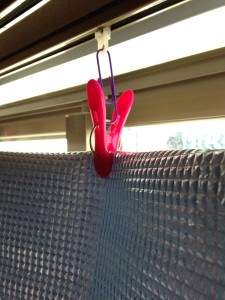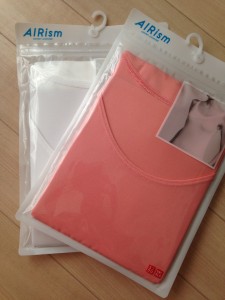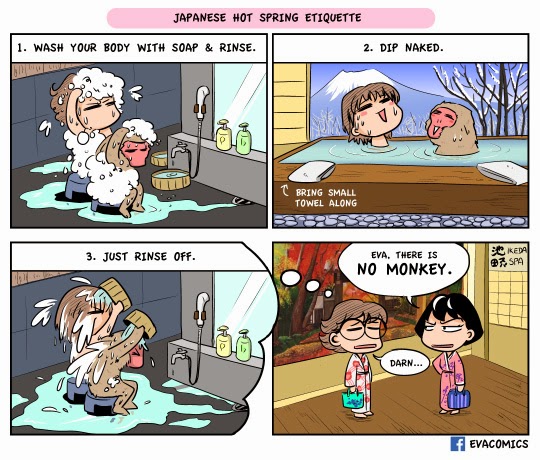Unconventional Ways to Beat the Heat
Is it humid? It feels a little humid to me.
As a second-year ALT, I knew it was coming. I knew that summer would make a grand entrance, bringing high temperatures, blazing sunlight, and moisture levels that seem to turn the air into a solid mass. No matter where you’re from originally, nearly all JETs can agree that summer in Japan is an intense experience. Here are few inexpensive and creative tips to beat the heat in your apartment, at work, and all those places in between.
#1: Seal your home!
You may have heard that Japanese housing structures lack insulation. Be your own hero by taking the time to seal your windows and door frames now! Not only will your efforts work to keep the heat out in summer, but you’ll have the additional barriers to help retain more heat during winter! Simple sealing processes can also act as reinforcements in the battle against bugs and other crawling creatures.
What you need:
Weather stripping, towels, scissors
Where to buy it:
100-yen stores, Konan, and other home improvement stores
How to install:
Weather stripping comes in coiled strips of varying width. This foam-like padding has double-sided tape on one edge. Be sure to wipe all surfaces first with a damp rag – window tracks, door frames, and any other nooks where weather stripping would be appropriate. Then peel back the tape and slowly apply the foam.
Pro tip:
I went a bit crazy this winter with weather stripping. I stuffed the foam into all of the tracks of my sliding windows as well as exterior and interior edges. Unexpectedly, the foam forced my windows to sit tighter in their frames. This stopped the rattling during windy storms and made the windows fit more snuggly (though sometimes making the windows difficult to close all the way). Rolled towels can also be used at the bottom of door frames and large sliding doors that lead to balconies.
#2: Clean your air-con/ heater!
If you have an AC unit installed in your home, it probably doubles as a heater (and maybe a de-humidifier, fan, and clothes-dryer). A simple way to help manage your electricity bill is to be sure your unit is working efficiently. So give your favorite appliance some TLC by cleaning the filter!
What you need:
Your air-con filter, a shower
Where to buy it:
New filters can be purchased at home improvement stores; hopefully you have the shower part covered
How to:
I confess, I dreaded cleaning my air-con’s filter after several long winter months of use. I knew it had to be done but I envisaged endless amounts of dust, hair balls, mold, and dirt blowing all over my apartment the minute I opened the casing. Fortunately, a good friend told me to stop procrastinating and suggested I just put the filters in the bathtub and use my shower to clean them. Brilliant! The filters pop out easily; you can use a trash bag to contain any dust while walking from the air-con to the bathroom (which probably isn’t a great distance). Then I just turned on the shower and all of the filter’s accumulated lint and dust washed right off! I didn’t even need elbow grease. Twenty minutes later, the filters were dry and ready to be re-installed. Since then, I have noticed that my air-con unit runs more evenly with a stronger airflow.
 #3: Get rid of the sun!
#3: Get rid of the sun!
Like many life forms, we need sunlight to grow and stay healthy. That does not mean that we need endless amounts of burning sunrays baking our homes 24/7. Closing the curtains when you leave for work is a big help (and any chocolate-based omiyage you may have stored will fare better). If you’re feeling creative, you can also make your own Super Curtain to send that sun right back where it came from!
What you need:
A large piece of sun reflector material (like a car shade), clothes pins, paper clips
Where to buy it:
100-yen stores, home improvement stores, car supply stores
How to install:
I can’t take full credit for this idea; I found it online somewhere. I wanted to block the sun from entering through my large sliding glass doors without investing in extremely expensive curtains. I’m cheap and I like to save money. I purchased a large sheet of sun reflective material from Konan for less than \1,000. Then I folded the sheet like an accordion and placed heavy boxes and other weights on the sheet for several days. Once the folds were pressed, I hung the curtain from a spare curtain rod using clothes pins and paperclips. The trick is to hang the curtain with the reflective side facing out. This acts as a shield against the sunlight, forcing those rays to bounce back out into the world instead of into your apartment. The accordion folds help shrink the sheet when I want to access the door.
Pro tip:
When the winter months arrive and you set up a small heater in your room to keep away the chill, turn the curtain around, using the reflective side to keep the heat from escaping out of that giant window. This curtain has had a huge impact in my quest to keep my apartment at a comfortable temperature. Maybe it’s all placebo (I did not study thermo energy), but I encourage everyone to try it out!
 #4: Bring the cool with you!
#4: Bring the cool with you!
Small, hand-sized portable ice packs are quickly becoming a thing in Japan. Although they don’t last long, if you’re traveling from one cool space to another, but have to cross a desert in-between, bringing a small ice pack or two can help get you there safely. They come in names like “Pocket Cool†and “Cool Refresh Neckâ€. Pop them in the freezer and then apply to the back of your neck, wrists, and lower back.
Where to buy it:
Most retail stores like Loft, random places in Aeon or Itoyokado
Pro tip:
If you buy a slice of cake from Fujiya or a mildly expensive pastry from a fancy bakery, the packaging typically includes a few tiny icepacks to ensure that your treat remains in perfect condition. These ice packs can be re-frozen and used again and again. Freebie!
 #5: Fight the sweat!
#5: Fight the sweat!
Some days, the humidity is so high that even a five minute walk to the train station can leave you longing for a change of clothes. A simple trick is to actually bring a change of clothes. But if you’re set on one outfit a day, some retailers have gone the extra mile by manufacturing shirts and under-layers designed to absorb your sweat for you!
Where to buy it:
Uniqlo, similar clothing stores, and high end athletic stores
Pro tip:
Uniqlo sells pre-packaged tank tops made with a special “AIRism†material. According to the ads, these shirts also control odor! While adding layers may seem counter-intuitive, these lightweight undershirts are very good at keeping your skin dry and keeping your outer layer of clothes less sweaty and more presentable. Frequent re-application of deodorant also helps.
#6: Know your office!
Maybe your school has air-cons in every classroom. Maybe your school doesn’t have any air-cons in any classrooms. Maybe the teacher’s room is a cool oasis in the corner of a concrete sauna. Maybe the teacher’s room is the hottest place you’ve ever experienced because it’s packed full with seventy-plus people. Beating the heat at school can be the most challenging fight in summer because we also want to maintain a level of professionalism. Hopefully, your school has some form of climate control even if it’s just an electric fan in the corner by the copy machine. If this is true for you, start making copies! If the only air-con in the office is in the far corner near the PE teachers, start chatting up those PE teachers! Moving around the office will help you get to know different colleagues. If you’re strategic, you can also regulate your body temperature while being a social butterfly.
Pro tip:
Stock up on cute and culturally hip tenugui, or sweat towels. These are great conversation starters that can buffer the awkwardness of mopping perspiration off your face while several coworkers crowd your desk for early morning conversation.
Claire Bronchuk






